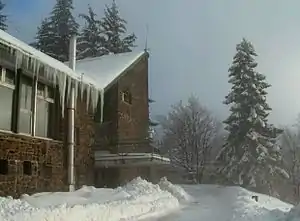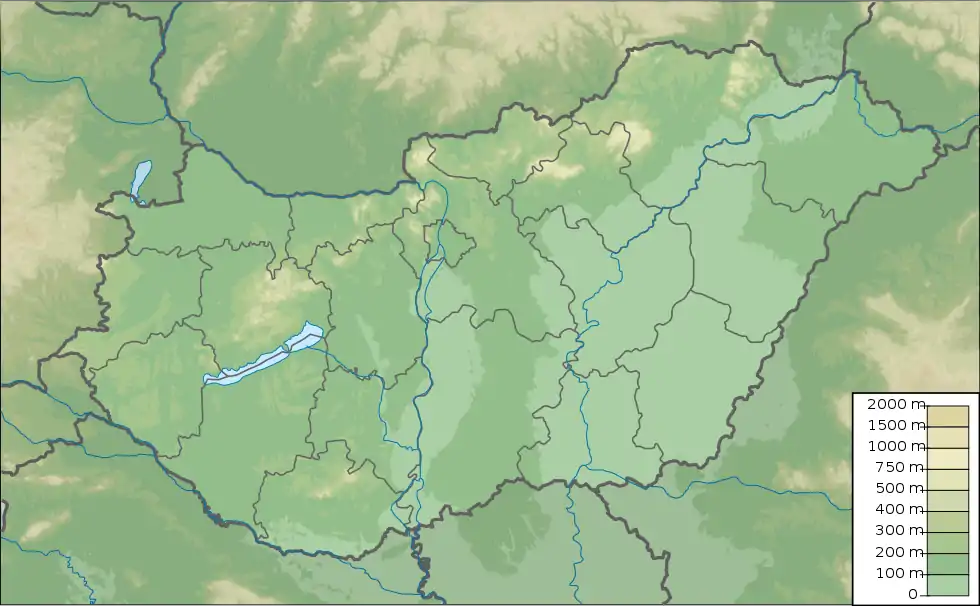47°55′05″N 019°53′39″E / 47.91806°N 19.89417°E
 | |||||||||
| Named after | Piszkés-tető | ||||||||
|---|---|---|---|---|---|---|---|---|---|
| Organization | Hungarian Academy of Sciences | ||||||||
| Observatory code | 461 | ||||||||
| Location | Piszkéstető, Mátra Mountains, Hungary | ||||||||
| Coordinates | 47°55′05″N 019°53′39″E / 47.91806°N 19.89417°E | ||||||||
| Established | 1958 | ||||||||
| Website | www | ||||||||
| Telescopes | |||||||||
| |||||||||
 Location of Piszkéstető Station | |||||||||
| | |||||||||
The Piszkéstető Station or Piszkéstető Mountain Station is an astronomical observatory in Mátraszentimre in Mátra Mountains, about 80 kilometers (50 mi) northeast of Hungary's capital Budapest. It is a station of Konkoly Observatory, first built in 1958. It has the observatory code 461 and 561 for being used by the Szeged University and Konkoly Observatory, respectively.[1]
Instruments
The observatory features four telescopes:[2]
- 60/90/180-centimetre Schmidt telescope since 1962
- 50-centimetre Cassegrain telescope since 1966
- 1-metre Ritchey–Chrétien telescope since 1974
- 40-centimetre Ritchey–Chrétien telescope since 2010
Discovery of 2022 EB5
Piszkéstető Station discovered asteroid 2022 EB5, which later impacted earth. It is only the fifth asteroid in history to have been discovered prior to impact. This puts the station in a very short list of observatories that have achieved this feat. Several asteroids impact earth every year with enough force to be detected by infrasound sensors designed to detect detonation of nuclear devices, but the vast majority of impacts are unpredicted and occur without warning.[3] Piszkéstető Station discovered this asteroid before it impacted.[4]
Honors
The minor planet 37432 Piszkéstető was named after the station, where it was discovered by astronomers Krisztián Sárneczky and Zsuzsanna Heiner in January 2002.[1]
List of discovered minor planets
A total of 19 minor planet discoveries are credited directly to the Piszkéstető Station by the Minor Planet Center.[5]
| 181136 Losonczrita | 25 August 2005 | list |
| (238623) 2005 CL12 | 1 February 2005 | list |
| (240364) 2003 SQ129 | 20 September 2003 | list |
| (290129) 2005 QC152 | 31 August 2005 | list |
| (334756) 2003 RP7 | 4 September 2003 | list |
| (345648) 2006 TZ6 | 1 October 2006 | list |
| (378920) 2008 UP95 | 24 October 2008 | list |
| (384459) 2010 BM4 | 24 January 2010 | list |
| (390743) 2003 SD129 | 20 September 2003 | list |
| (399565) 2003 SZ128 | 20 September 2003 | list |
| (405571) 2005 QE87 | 31 August 2005 | list |
| (413233) 2003 SB129 | 20 September 2003 | list |
| (423380) 2005 JD94 | 12 May 2005 | list |
| (423433) 2005 QL75 | 29 August 2005 | list |
| (446957) 2003 SD127 | 19 September 2003 | list |
| (461650) 2005 GP9 | 3 April 2005 | list |
| (464745) 2003 RQ7 | 5 September 2003 | list |
| (469773) 2005 QB76 | 30 August 2005 | list |
| (474440) 2003 NH5 | 5 July 2003 | list |
Gallery

See also
References
- 1 2 "37432 Piszkesteto (2002 AE11)". Minor Planet Center. Retrieved 16 December 2015.
- ↑ 40cm RC Telescope
- ↑ "Fireball and bolide reports". Jet Propulsion Laboratory. Archived from the original on 6 March 2013. Retrieved 25 March 2022.
- ↑ Antier, Karl (13 March 2022). "2022 EB5 : 5th predicted Earth impact!". International Meteor Organization. Retrieved 15 March 2022.
- ↑ "Minor Planet Discoverers (by number)". Minor Planet Center. 14 November 2016. Retrieved 28 November 2016.